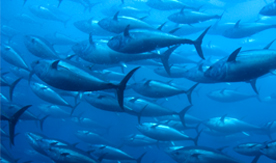 Bluefin tuna are going hungry in a sea full of fish because their foraging habits are most efficient with larger — not necessarily more abundant — prey, according to a study led by a University of Maine marine scientist.Walter Golet, assistant research professor in the School of Marine Sciences and the Gulf of Maine Research Institute, led a research team that involved marine scientists from five institutions, including Bigelow Laboratory for Ocean Sciences, University of Massachusetts Amherst and Simon Fraser University.
Bluefin tuna are going hungry in a sea full of fish because their foraging habits are most efficient with larger — not necessarily more abundant — prey, according to a study led by a University of Maine marine scientist.Walter Golet, assistant research professor in the School of Marine Sciences and the Gulf of Maine Research Institute, led a research team that involved marine scientists from five institutions, including Bigelow Laboratory for Ocean Sciences, University of Massachusetts Amherst and Simon Fraser University.
How can bluefin tuna go hungry in a sea full of fish?
In a paper in the journal Marine Ecology Progress Series titled “The paradox of the pelagics: why bluefin tuna can go hungry in a sea of plenty,” the seven authors outlined how the overall condition (fat content) of Atlantic bluefin tuna Thunnus thynnus in the Gulf of Maine declined despite an abundance of Clupea harengus, Atlantic herring — their preferred prey.
The Gulf of Maine is an important foraging ground for bluefin tuna, which spend up to six months there consuming high-energy prey such as the herring and in doing so accumulate as much as 200 pounds in fat. Energy acquired in the Gulf of Maine is vital to support bluefin tuna migration and reproduction.
The population of Atlantic herring has increased over the past two decades suggesting that foraging conditions should have been favorable for bluefin tuna. A decline in bluefin tuna condition despite abundant prey resources was puzzling, so the researchers tested hypotheses related to the energetic payoff of eating herring of different sizes, comparing this across different regions of the northwest Atlantic. Researchers had expected to find that due to the high abundance of herring in the Gulf of Maine, foraging would have been favorable for the bluefin tuna, thereby increasing their lipid stores and overall body condition. Their results suggest bluefin tuna are more sensitive to the size of their prey rather than prey abundance (i.e., for bluefin, bigger prey is better than smaller prey).
Researchers identified a correlation between bluefin tuna body condition, the relative abundance of large Atlantic herring and the energetic payoff resulting from consuming different sizes of herring. The correlation is consistent with the optimal foraging theory, a model used to predict how an animal behaves when it’s searching for food.
These correlations could explain why the condition of bluefin tuna suffers even when prey is abundant. According to the researchers, this may also explain a shift in distribution of bluefin tuna to offshore banks and locations further north on the northwest Atlantic shelf where herring (and their corresponding energetic payoff) are larger.
Management strategies for small pelagic fish, including sardines, herrings and anchovies, have the potential to alter food web dynamics and energy flow through changes in the size and abundance of these species. Changes in these fish stocks impact marine mammals and other large warm-bodied fish (like bluefin tuna) whose physiology is geared toward high energetic returns while foraging.
The researchers utilized the extensive data collected from the Maine Department of Marine Resources, the Canadian Department of Fisheries and Oceans and the National Marine Fisheries Service.
Contact: Amanda Clark, 207.581.372

